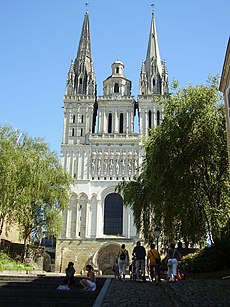Roman Catholic Diocese of Angers
|
Diocese of Angers Dioecesis Andegavensis Diocèse d'Angers |
|
|---|---|

|
|
| Location | |
| Country | |
| Ecclesiastical province | Rennes |
| Metropolitan | Archdiocese of Rennes, Dol, and Saint-Malo |
| Statistics | |
| Area | 7,166 km2 (2,767 sq mi) |
| Population - Total - Catholics |
(as of 2012) 783,000 566,000 (72.3%) |
| Parishes | 85 |
| Information | |
| Denomination | Roman Catholic |
| Sui iuris church | Latin Church |
| Rite | Roman Rite |
| Established | 372 |
| Cathedral | Cathedral of St. Maurice in Angers |
| Patron saint | Saint Maurice |
| Current leadership | |
| Pope | Francis |
| Bishop | Emmanuel Delmas |
| Metropolitan Archbishop | Pierre d'Ornellas |
| Emeritus Bishops | Jean Pierre Marie Orchampt Bishop Emeritus (1974-2000) |
| Website | |
| Website of the Diocese | |
The Roman Catholic Diocese of Angers (Latin: Dioecesis Andegavensis; French: Diocèse d'Angers) is a diocese of the Latin Rite of the Roman Catholic church, in France. The episcopal see is located in Angers Cathedral, in the city of Angers. The diocese extends over the entire department of Maine-et-Loire.
It was a suffragan see of the Archdiocese of Tours under the old regime as well as under the Concordat. Currently, the diocese is a suffragan of the Archdiocese of Rennes, Dol, and Saint-Malo.
The first Bishop known in history is Defensor, who, when present in 372, at the election of the Bishop of Tours, made a determined stand against the nomination of Saint Martin. The legend concerning the earlier episcopate of a certain Auxilius, is connected with the cycle of legends that centre about Saint Firmin of Amiens and is contradicted by Angevin tradition from before the thirteenth century.
Among the illustrious names of the Diocese of Angers during the first centuries of its existence are those of Saint Maurilius, disciple of Saint Martin, and at an earlier period hermit of Chalonnes, who made a vigorous stand against idolatry, and died in 427; Thalassius, consecrated bishop in 453, who has left a compendium of canon law, consisting of the decisions of the councils of the province of Tours; Saint Albinus (sixth century); Saint Licinius, former Count of Anjou, and bishop during the early part of the seventh century.
...
Wikipedia
